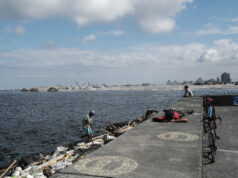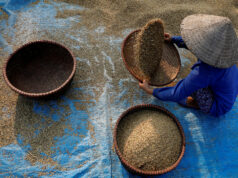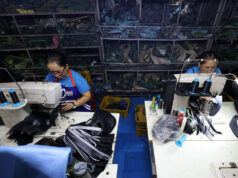US asserts place in Indo Pacific amid China’s gains in the region
By Cathy Rose A. Garcia
Associate Editor
BANGKOK, THAILAND — The United States is moving to reassert its economic influence in the Indo-Pacific region, amid a long-drawn out trade war with China and as some countries, including the Philippines, have increasingly turned to their northern neighbor for investments to fund infrastructure projects.
“The Trump administration is extremely engaged in and fully committed to this region. Two-way trade between the US and the Indo-Pacific increased by almost six percent last year to a record $2 trillion… It far surpasses US bilateral trade with Europe $1.5 trillion, and bilateral trade with South and Central America, $1.2 trillion,” US Commerce Secretary Wilbur Ross said during his keynote address at the Indo-Pacific Business Forum here on Nov. 4.
Despite trade tensions denting economic growth in the region, Mr. Ross noted that the United States is the largest source of foreign direct investments (FDI) in the region, which stood at $866 billion as of end-2018. To compare, he said China’s FDI into the region reached $504 billion, “of which $381 billion went to Hong Kong, $123 billion for the rest.”
“Now I have thrown a large amount of numbers at you today and there’s a reason for that. They prove our deep and continuing commitment to the region. As you gather again in future years, our numbers will only get bigger,” Mr. Ross added.
The Trump administration has been pursuing its Indo-Pacific strategy, which is widely seen as the United States’ effort to counter China’s growing influence and expanding investments in the region.
In the Free and Open Indo-Pacific: Advancing a Shared Vision report released on Nov. 4, the US State Department detailed the Trump administration’s efforts to strengthen its partnerships with countries such as India, Australia, Philippines and other members of the Association of Southeast Asian Nations (ASEAN).
“Under President Trump’s leadership, the United States is implementing a whole-of-government strategy to champion the values that have served the Indo-Pacific so well: (1) respect for sovereignty and independence of all nations; (2) peaceful resolution of disputes; (3) free, fair, and reciprocal trade based on open investment, transparent agreements, and connectivity; and (4) adherence to international law, including freedom of navigation and overflight,” the report read.
PRIVATE SECTOR TO LEAD THE WAY
At Indo-Pacific Business forum, US government officials made a pitch for “sustainable” private sector-led investments in the region, particularly in infrastructure that is “physically secure, financially viable and socially responsible.”
“(This) is a premiere event which is a whole-of-government effort to unlock private sector-led growth in the region, which is vital to our and the world’s economic health. Our goal is to highlight the benefits of partnering with a dynamic US private sector, and the critical role of market-based economic system, private sector finance and open investment environments in driving the region’s success,” Alice Wells, acting assistant secretary for South and Central Asia at the US Department of State, said at a press briefing on the sidelines of the forum.
Unlike China whose state-owned companies invest in infrastructure projects around the region, Ms. Wells said the US does business through the private sector.
“I don’t walk into the room with a pair of state-owned companies and a financing package. We introduce the leading, most modern, competitive, technologically-advanced firms in the region, and when they see an opportunity in a free market to make an investment that would provide returns, so the private sector model is going to deliver infrastructure that makes sense, makes dollars and sense for everyone involved,” she said.
The Indo-Pacific region requires significant investments for the development of infrastructure, which the World Bank estimated at up to $50 trillion by 2040. The International Energy Agency projected that the Indo-Pacific region will require more than $1 trillion in annual energy infrastructure investments.
“The Indo-Pacific region requires quality infrastructure to support and sustain its dynamic economic growth,” Thomas R. Hardy, acting director of the US Trade and Development Agency, said.
However, many countries, including the Philippines, have turned to China to help finance massive infrastructure projects such as ports, bridges and railways under the Belt and Road Initiative (BRI).
US PRESSES ALTERNATIVES TO CHINA
US Agency for International Development (USAID) Deputy Administrator Bonnie Glick expressed some concern about Indo-Pacific countries’ cooperation with China under BRI.
“It’s not that we’re saying don’t engage with China at all. What we’re saying is there are options out there. One of the things that happen when countries go down that One Belt, One Road is that they lose sight of the fact that there are other options out there,” Ms. Glick said in a separate press briefing.
“Transparency in all procurements is the best way to ensure the maintenance of a nation’s own sovereignty and that a nation maintains control of the development of its own projects… We’re not saying there is only one solution. We’re saying that there are always multiple solutions,” she added.
In the Free and Open Indo-Pacific report, the US Department of State said its “economic engagement seeks to equip states to resist coercive economic practices, unsustainable debt burdens and other dangers.”
On digital economy, the US State Department urged all countries to “take a risk-based approach to evaluating technology vendors, including those that night be subject to control by or the undue influence of foreign powers.”
And in an effort to distinguish infrastructure projects, the United States, Japan and Australia launched the Blue Dot Initiative, which will certify high-quality infrastructure. However, details on these “shared” standards of global infrastructure development were sparse.
‘GREAT ALLY’
Since the start of his term, President Rodrigo R. Duterte has sought to deepen ties with China, as he hopes to secure billions of dollars of investments and official development assistance for his P8-trillion Build, Build, Build infrastructure development program.
He touted his “separation” from Washington during his October 2016 visit to Beijing.
Amid the Philippines’ pivot towards to China, US Department of State Acting Undersecretary Keith Krach said the United States remains fully committed to its long-time ally in the region.
“The Philippines has always been a great ally and a friend… It hasn’t fallen off any priorities, and now more than ever, you can see that in our private sector… There’s so much opportunity there. You are rest assured the Philippines has not fallen down any priority list,” Mr. Krach said during a press briefing at the sidelines of the Indo-Pacific Business Forum.
However, the Philippines was noticeably not included in Mr. Ross’ itinerary, as he led a delegation of top executives from Boeing, Tesla, Honeywell International, Lockheed Martin and Qualcomm to Thailand, Vietnam and Indonesia.
In 2018, FDI net inflows to the Philippines fell 4.5% to $9.8 billion. Of the $2.3 billion in equity capital investment, placements from the US slumped 66% to $160 million from $472.9 million in 2017.
“When I speak to representatives of American companies in this region, what they’re looking for is transparency, predictability, understanding of government’s long-term plans in terms of infrastructure,” Ms. Wells said when asked what the Philippines can do to boost its attractiveness to US investors.
Ms. Wells noted US investors take note of a country’s ranking in the World Bank’s (WB) Ease of Doing Business (EODB) survey, Freedom House’s Freedom in the World, and other surveys.
In the WB Doing Business 2020 report, the Philippines’ ranking rose to 95th place out of 190 economies, from 124th last year. It ranked 11th among 25 countries in East Asia and the Pacific.
The Philippines fell eight notches to 64th out of 141 economies in the World Economic Forum’s Global Competitiveness Report 2019.
Freedom House gave the Philippines an aggregate freedom score of 61/100, or “partly free” for 2018, noting “rule of law and application of justice are haphazard and heavily favor ruling elites.”
“(Companies look at) the rule of law, regulatory environment, transparency, ease of doing business… Fundamentally, it’s about governance. For the United States, because our model is one led by the private sector, we don’t force companies to invest in countries… The company has to be attracted to the potential that exists. It doesn’t mean that companies won’t take risks, they do, companies are motivated by the opportunity to generate profits and ultimately, it’s that profit motive and bottom line that brings the most efficient and technologically advanced businesses to the Philippines and elsewhere,” US State Department’s Ms. Wells said.
American Chamber of Commerce of the Philippines, Inc. Senior Adviser John D. Forbes, said that while the Philippines “has been attracting more US investment in recent years”, improvements are needed.
“The things that can be improved in order to attract more FDI are public knowledge from the multiple global rankings made by GCI (Global Competitiveness Index), IMD (International Institute for Management Development), WB, and WEF (World Economic Forum). Aside from the excessive red tape, which we expect the EODB and ARTA (Anti-Red Tape Authority) will reduce, there is much-increased spending on needed infrastructure,” he said in a mobile phone message.
“We hope more power and water capacity can be built soon to avoid shortages and broadband greatly improved. President Duterte is asking to further open the economy to encourage more FDI with amendments to FIA (Foreign Investments Act), and Retail Trade laws and even foreign equity provisions of the Constitution. We are always optimistic about the future prospects for the hard-working and talented Filipino people.”



